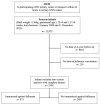Influenza Immunization in Very-Low-Birth-Weight Infants: Epidemiology and Long-Term Outcomes
- PMID: 39852821
- PMCID: PMC11769184
- DOI: 10.3390/vaccines13010042
Influenza Immunization in Very-Low-Birth-Weight Infants: Epidemiology and Long-Term Outcomes
Abstract
Background: Very-low-birth-weight infants (VLBWIs; birth weight < 1500 g) are at an increased risk of complicated influenza infection, which frequently includes pneumonia, encephalitis or even death. Data on influenza immunization and its outcome in VLBWIs are scarce. This study aimed to provide epidemiological data on influenza immunization for German VLBWIs and hypothesized that immunization would protect VLBWIs from infection-mediated neurodevelopmental impairment and preserves lung function at early school age.
Methods: In this observational population-based German Neonatal Network (GNN) study, infants born between 2009 and 2015 were invited to partake in a 6-year follow-up investigation including lung function and developmental testing. Uni- and multivariate analyses were performed to evaluate the clinical characteristics and outcomes of influenza-immunized VLBWIs compared to non-immunized VLBWIs.
Results: Influenza immunization was performed in 871 out of the 3358 VLBWIs (26%) with six-year follow-up. Immunized infants were characterized by a low gestational age and higher rates of morbidity, particularly bronchopulmonary dysplasia. Although early immunization showed no safety signals and had protective effects on the long-term risk of bronchitis (OR: 0.2; CI: 0.1-0.6; p = 0.002), most VLBWIs (88.0%) were unimmunized in their first influenza season.
Conclusions: Influenza immunization was not associated with improved lung function (forced expiratory volume in one second and forced vital capacity) or a better neurocognitive outcome (intelligence quotient and strengths and difficulties questionnaire) at early school age. In Germany, only one quarter of 6-year-old VLBWIs were immunized against influenza, particularly those born <28 gestational weeks and/or BPD. Specific influenza immunization guidelines that define evidence-based recommendations are needed for this vulnerable group.
Keywords: VLBWI; immunization; influenza; lung function.
Conflict of interest statement
The authors declare no conflict of interests. There has been no involvement in study design, collection of analysis, interpretation of data, writing of the report and decision to submit the manuscript for publication by the German Ministry for Education and Research. No payment, honorarium, grant, or other form of payment has been given to the authors.
Figures




References
-
- Keller R.L., Feng R., DeMauro S.B., Ferkol T., Hardie W., Rogers E.E., Stevens T.P., Voynow J.A., Bellamy S.L., Shaw P.A., et al. Bronchopulmonary Dysplasia and Perinatal Characteristics Predict 1-Year Respiratory Outcomes in Newborns Born at Extremely Low Gestational Age: A Prospective Cohort Study. J. Pediatr. 2017;187:89–97.e3. doi: 10.1016/j.jpeds.2017.04.026. - DOI - PMC - PubMed
-
- Wang X., Li Y., O’Brien K.L., Madhi S.A., Widdowson M.A., Byass P., Omer S.B., Abbas Q., Ali A., Amu A., et al. Global burden of respiratory infections associated with seasonal influenza in children under 5 years in 2018: A systematic review and modelling study. Lancet Glob. Health. 2020;8:e497–e510. doi: 10.1016/S2214-109X(19)30545-5. - DOI - PMC - PubMed
-
- Trusinska D., Zin S.T., Sandoval E., Homaira N., Shi T. Risk Factors for Poor Outcomes in Children Hospitalized With Virus-associated Acute Lower Respiratory Infections: A Systematic Review and Meta-analysis. Pediatr. Infect. Dis. J. 2024;43:467–476. doi: 10.1097/INF.0000000000004258. - DOI - PMC - PubMed
Grants and funding
LinkOut - more resources
Full Text Sources

